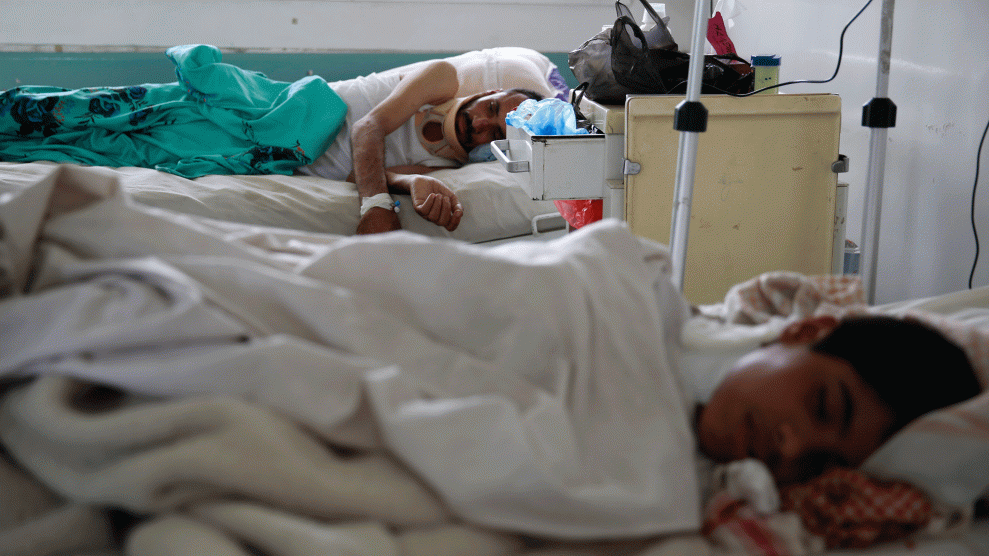
A man injured in a Saudi-led airstrike lies on a hospital bed in Sanaa, Yemen.Hani Mohammed/AP
It wasn’t that long ago that Syrians were enjoying a steady increase in life expectancy—about a three-month bump every single year for more than two decades. Same for the residents of Yemen, Libya, and Egypt, who saw improvements in life expectancy and an array of other health indicators from 1990 until the Arab Spring uprisings began spreading in late 2010.
“Keep in mind that this region has not been stable for a long time, has had a lot of unrest, and against all odds we had seen an improvement in health,” says Ali Mokdad, a professor at the Institute for Health Metrics and Evaluation at the University of Washington in Seattle. But those slow gains have been all but erased. “Immediately after the uprisings,” he says, “we see a rapid decline of all the health indicators, in a short time wiping out a lot of progress that has been made.”
Mokdad is the lead author of a new study published yesterday in The Lancet Global Health that analyzes health problems and mortality in 22 countries across the Middle East, North Africa, and Central Asia from 1990 to 2013. Its findings are stark: The recent uprisings in Libya, Iraq, Tunisia, Egypt, Yemen, and Syria have caused a drop in life expectancy in those countries, with Syria suffering the most. Between 2010 and 2013, Syria’s life expectancy for men fell from 75 years to 69 years; for women, it dropped from 80 years to about 75 years. Other countries suffering from conflict and insecurity lost about three months of life expectancy. That’s a dramatic decrease considering that they previously had been on track to keep improving, and the life expectancy in their more stable neighbors rose during the same period.
It’s not just bombs and bullets causing severe, long-term health impacts in these countries. Diseases that had been all but eradicated have returned. Infant mortality rates are on the rise in Syria. Health care infrastructure is being wiped out, leaving the ill and injured without access to basic care that would otherwise save their lives. In both Yemen and Syria, where medical facilities have been targeted in bombing campaigns, preventable illnesses and diseases are claiming an alarming number of lives.
Deaths from diabetes rose from 12 to 19 per 100,000 people across the Eastern Mediterranean region over the two decades reviewed. Malnutrition, the lack of clean water, and poor sanitation have contributed to the spread of infectious diseases like Middle East Respiratory Syndrome (MERS) and tuberculosis. Mokdad says that in countries like Syria, which has now effectively “lost all of its protective mechanisms,” people are dying at a higher number from “diseases that have never killed them before. Some of our young physicians haven’t even seen some of these illnesses,” he notes.
In war zones, women of childbearing age and children under five are often the hardest hit. “Their reserves are depleted,” says Mokdad, and they fall into “a vicious cycle” of dehydration, malnutrition, illness, and often ultimately death. Children younger than five contributed to a third of all health losses—that is, people living with a disability or illness—in 2013, the report notes.
There is one kernel of optimism in the study: Among the region’s 22 nations as a whole, life expectancy was on the rise—at least until 2013, when the data stops. Since then, as Mokdad explains, “The war has intensified in Syria. There is a bloody war in Yemen. There is a bloody war in Libya. There is still unrest in Egypt and Tunisia. We are underestimating the burden on people and the suffering of the region.”
Riyadh Lafta, the paper’s comment author and an epidemiologist and professor at the Mustansiriya Medical School in Baghdad, said in an email, “It is a bit confusing how life expectancy improved with all this mess of sectarian wars, terrorism, bombing, and deterioration of health services and infrastructure! I think that the reason behind this is that some of the included ‘stable’ countries might change the picture by diluting the effect of wars and violence on the morbidity, mortality, and disability rates.”
Lafta then offered a prediction for the future. He said simply, “The situation will get worse.”













